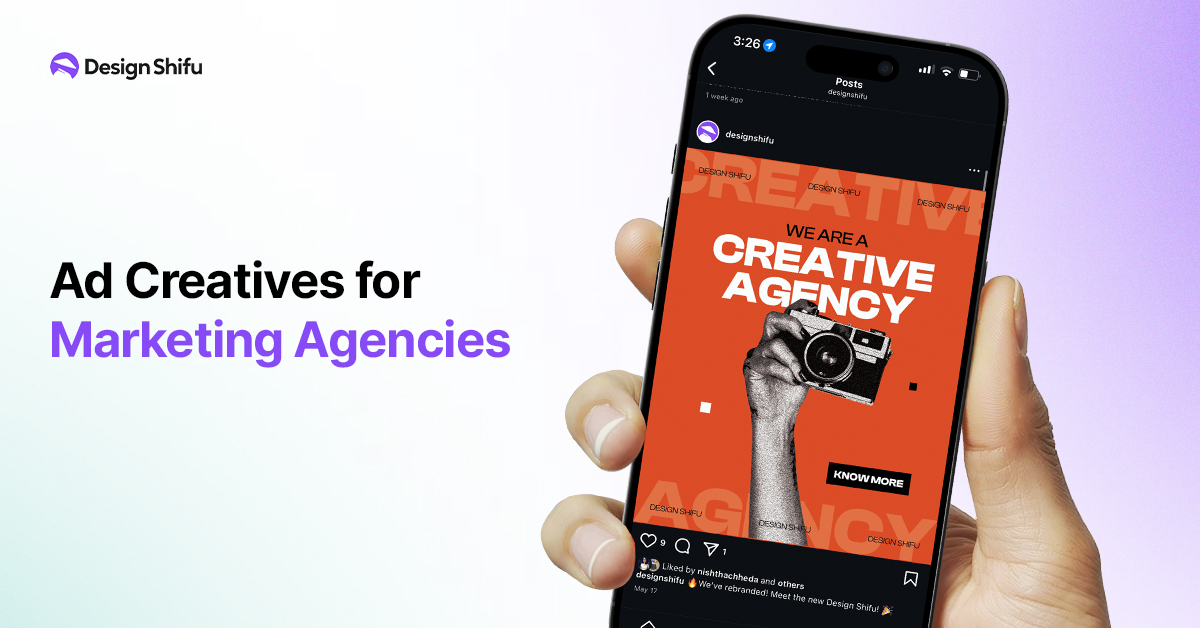In terms of internet marketing, Retargeting vs Remarketing: Know the Difference Before You Spend Money is a vital consideration for companies that seek to make their marketing strategy better. Though used interchangeably by many, both are different methodologies that have different effects on your campaign and advertising expenditure.
The knowledge of what separates retargeting and remarketing ensures that you’re investing smart and targeting the appropriate customers. In this blog, we’ll explain both strategies, their differences, and how to use them effectively for your business.
What makes remarketing and retargeting so compelling, sparking ongoing debates about which is better for your marketing budget? Let’s break it down:
Firstly, both strategies help you maximize your existing web traffic. Not all visitors will convert on their first visit, but with remarketing and retargeting, you have the chance to reignite their interest.
Secondly, they’re highly cost-effective. You’re not bombarding the entire internet with ads; you’re laser-focused on the people who have already shown interest in your products or services. This efficiency translates to a better return on investment.
Furthermore, these techniques aid in building brand awareness and trust. The more a potential customer sees your brand, the more likely they are to consider you a credible option when they’re ready to make a purchase.
In a competitive world with short attention spans, remarketing and retargeting emerge as powerful tools to keep your brand in the minds of potential customers.
Now that you understand their importance, let’s dive into the differences between retargeting and remarketing campaigns.
What Is Retargeting?
Retargeting allows you to reach potential customers who have shown interest in your business. By targeting specific pages and actions taken on your website, you can increase brand awareness, boost conversion rates, and maximize ROI by focusing on those who have already expressed interest.
What Is Remarketing?
Remarketing is a potent strategy to engage previous customers and encourage repeat purchases. By creating personalized email campaigns based on purchase history and targeting specific segments with remarketing emails, businesses can increase brand loyalty and drive conversions.
Why the Remarketing vs. Retargeting Confusion?
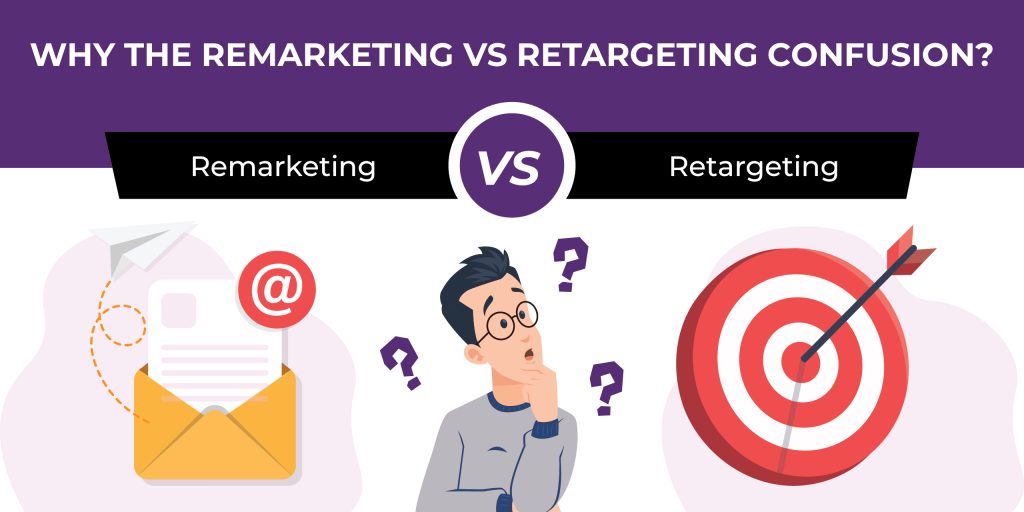
Remarketing and retargeting may seem like twins separated at birth, but they’re distinct marketing strategies in the same family tree. Imagine you’re at a party: remarketing is like reintroducing yourself to someone you met earlier, reminding them of your charm and allure. It’s about reconnecting with users who’ve interacted with your brand, nurturing that initial spark.
On the other hand, retargeting acts like the person who follows you around the party, making sure you never forget that interesting conversation you had. It involves showing ads to people who’ve visited your website or engaged with your content, keeping your brand in their minds.
In essence, remarketing is a broader term that encompasses all efforts to reconnect with past interactions, while retargeting is a specific technique within remarketing, involving ad display to website visitors.
Statistics on Retargeting and Remarketing
- Click-through rates for retargeted ads are approximately 10 times higher than regular display ads (Source: Inc. Magazine).
- Ad retargeting can result in a 38% increase in brand search, a 147% increase in direct traffic, and a 600% increase in branded search (Source: Criteo).
- Retargeted visitors are 70% more likely to convert compared to first-time visitors (Source: Criteo).
- Google Search Ads combined with retargeting can increase conversion rates by 161% (Source: WordStream).
- 70% of marketers claim that video is better for driving conversions compared to other forms of content (Source: Vidyard).
- 46% of marketers allocate over 50% of their online advertising budget to retargeting (Source: State of Inbound).
- According to SaleCycle, the average open rate for cart abandonment emails is 44.1%, with a click-through rate of 10.7%, and a conversion rate of 2.4%.
- 51% of marketers believe that retargeting on social media has a higher ROI than search retargeting (Source: Social Media Today).
- On average, dynamic remarketing ads lead to a 12% increase in conversions and a 50% decrease in cost per acquisition (Source: Google).
When Should You Use Retargeting vs Remarketing?
The user engaged but didn’t convert:
When a user views your product pages on your Shopify store but doesn’t commit, it’s the perfect moment for a retargeting campaign. Reconnect with shoppers, remind them of what they almost had, and nudge them toward making a purchase.
You wish to delight existing users:
If you have a loyal group of customers who adore your brand, use a remarketing campaign to nurture the relationship and deepen the connection. Share fresh content, new arrivals, or exciting offers with your VIP customers.
Someone abandoned your cart:
When a potential buyer abandons their cart, both retargeting and remarketing can be valuable. Use retargeting to remind them of the abandoned cart and offer an incentive to complete the purchase. Simultaneously, use remarketing to keep them engaged in the long run by showing them your range of products.
Cross-selling and upselling:
When you want to upsell or cross-sell to existing customers, rely on remarketing. Utilize your knowledge of their preferences and buying behavior to introduce them to complementary products and encourage them to explore more of what your brand offers.
Types of Remarketing
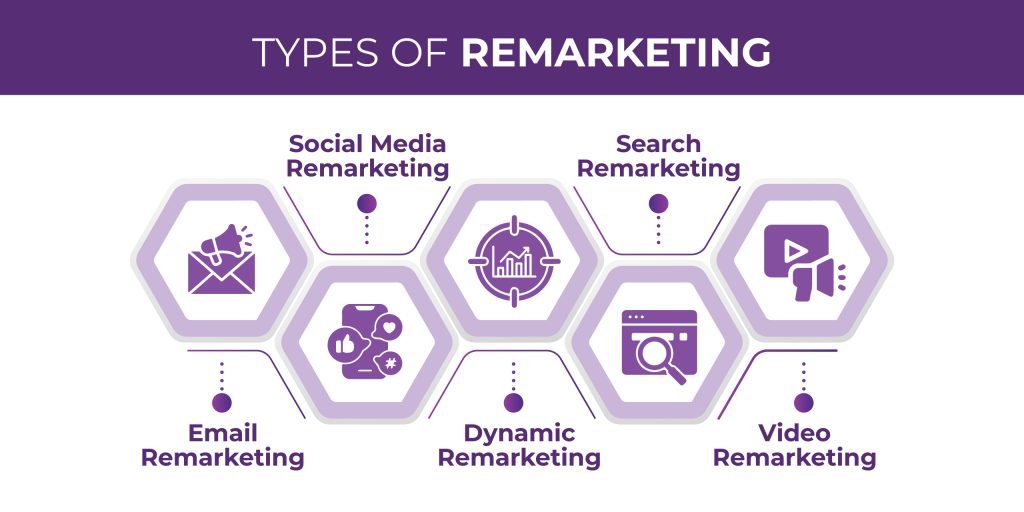
Remarketing is an effective strategy with various types, each offering unique benefits:
Email Remarketing:
- Reconnect with previous customers.
- Deliver tailored messages based on their purchase history.
- Encourage repeat purchases and brand loyalty.
For example, if you run an online fashion store, you can send personalized emails showcasing this year’s winter collection to a customer who bought a winter coat last year, complete with images of stylish new coats and a discount code.
Social Media Remarketing:
- Target site visitors with ads on platforms like Facebook, Instagram, and more.
- Expand your reach to users beyond your website.
- Drive engagement and conversions through familiar social channels.
For instance, if you operate a travel agency, use social media remarketing to display ads featuring stunning beachfront photos and travel deals to someone who visited your website to check out exotic beach destinations.
Dynamic Remarketing:
- Display related products to customers who’ve shown interest in a specific item.
- Enhance personalization and relevance.
- Boost cross-selling and upselling opportunities.
If your e-commerce store sells electronics, dynamic remarketing can show a visitor not only the laptop they viewed but also related accessories like a sleek laptop bag and a wireless mouse.
Search Remarketing:
- Display ads to potential customers who visited your website but didn’t convert.
- Reengage with users actively searching for products or services.
- Rekindle their interest and guide them back to your website.
For instance, if you run an online flower shop and a visitor explored your website for the perfect bouquet but left without making a purchase, search remarketing can remind them of your beautiful bouquets when they search for “fresh flower delivery.”
Video Remarketing:
- Target users who have interacted with previous video content on your website.
- Re-engage an audience interested in your video offerings.
- Drive them towards specific actions, such as signing up or making a purchase.
If your website features cooking tutorials and a user watched a video on “healthy and tasty food options,” use video remarketing to show them an ad highlighting your recipe e-book and encouraging them to download it.
Types of Retargeting
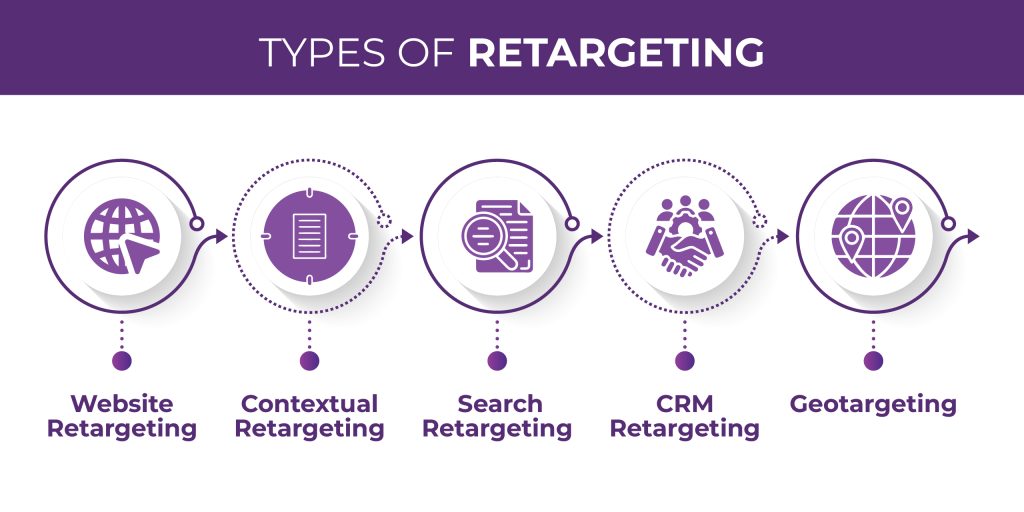
Website Retargeting
- Re-engage users who’ve previously visited your website.
- Display personalized ads based on their past interactions.
- Encourage them to return, complete actions, and convert.
For example, if you have an online bookstore, use site retargeting to show ads featuring gripping mystery books to a visitor who browsed your selection but left without buying.
Contextual Retargeting
- Target users based on the content they’ve engaged with.
- Ensure your ads align with their specific interests.
- Increase relevancy and click-through rates.
If your tech blog has a visitor who read an article about the latest smartphone trends, use contextual retargeting to display ads about upcoming smartphone releases and tech reviews on other websites catering to their tech-savvy interests.
Search Retargeting
- Display ads to users who’ve shown search intent but didn’t convert.
- Reach potential customers actively seeking products or services.
- Bring them back to explore and make a purchase.
For instance, if you run a travel agency and a user searches for “European vacation packages” on a search engine but doesn’t book, use search retargeting to remind them of your enticing vacation deals when they search for “best European travel destinations.”
CRM Retargeting
- Target users based on your existing customer data.
- Show ads to your loyal customer base and prospects.
- Strengthen relationships and encourage repeat business.
If your subscription-based streaming service wants to retain customers, use CRM retargeting to display ads for upcoming exclusive shows or special discounts to your existing subscribers.
Geotargeting
- Target users based on their geographical location.
- Promote location-specific offers or events.
- Increase foot traffic to your local business.
If you own a chain of coffee shops, use geotargeting to display ads promoting the nearest café’s “Buy One, Get One Free” offer to users in a specific city who visited your website but didn’t visit your café.
Remarketing and Retargeting Platforms and Tools
Both remarketing and retargeting have specific platforms and tools to help businesses reach their target audience effectively.
Remarketing Platforms and Tools
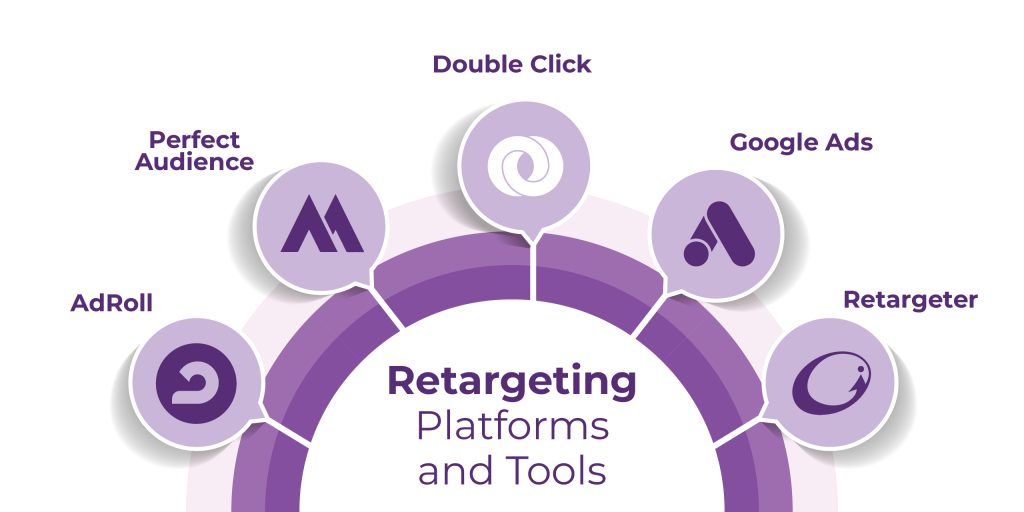
Google Ads (formerly AdWords)
Google Ads provides robust remarketing capabilities, enabling you to create remarketing lists and display ads across the Google Display Network, YouTube, and Google Search.
Meta Ads
Facebook (Meta) allows you to create custom audiences for remarketing, targeting users who’ve interacted with your page, app, or website—a powerful tool for social media remarketing.
Email Marketing Tools
Tools like Mailchimp, Constant Contact, and HubSpot allow you to segment and send personalized email campaigns for email remarketing.
AdRoll
AdRoll’s dynamic remarketing platform enables you to create and serve personalized, dynamic ads to past website visitors based on their browsing behavior.
Criteo
Criteo specializes in e-commerce remarketing, offering dynamic retargeting and personalized advertising solutions across various devices and platforms.
Retargeting Platforms and Tools
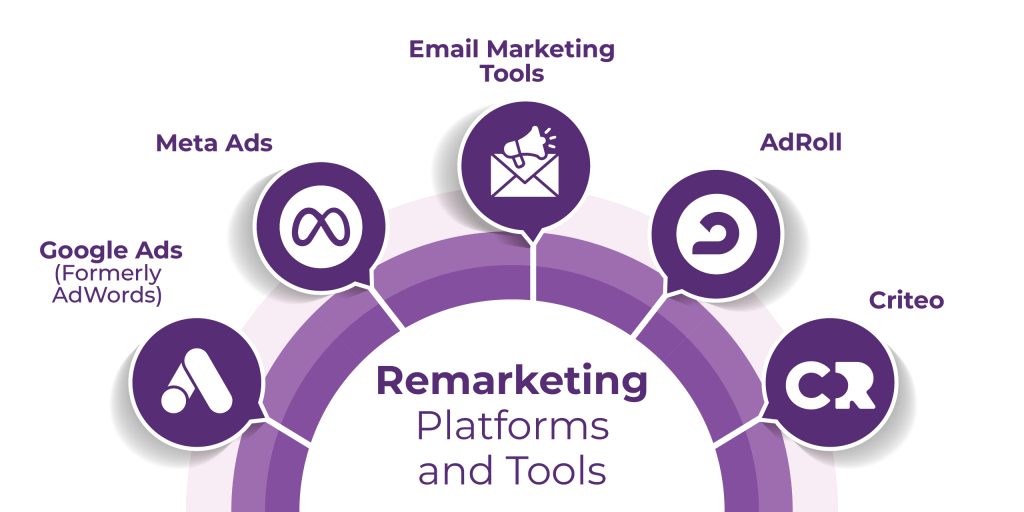
AdRoll
AdRoll provides a comprehensive retargeting solution covering web, social, and email retargeting, making it a versatile tool for businesses of all sizes.
Perfect Audience
This platform specializes in web and social media retargeting, allowing you to create and manage retargeting campaigns easily.
DoubleClick
Now part of the Google Marketing Platform, DoubleClick offers a suite of advertising and marketing solutions, including advanced retargeting options.
Google Ads
While Google Ads can be used for both remarketing and retargeting, it’s a powerful tool for creating retargeting campaigns, especially for search retargeting.
Retargeter
Retargeter is a platform specializing in web and search retargeting, offering features like cross-device targeting and site-specific targeting.
Retargeting vs. Prospecting
Retargeting and prospecting are two distinct strategies in digital marketing. It focuses on targeting customers who have already shown interest, while prospecting aims to reach new customers. Retargeting ads can be highly effective for driving conversions and leveraging previous interactions to reconnect with potential buyers.
On the other hand, prospecting campaigns target potential customers who exhibit similarities to the target audience. Both retargeting and prospecting have their place in a well-rounded marketing strategy, serving different goals. When deciding between the two, it’s important to consider the goals of the campaign and the different stages of the marketing funnel.
By carefully evaluating the objectives and target audience, businesses can make informed decisions on whether to prioritize retargeting or prospecting campaigns.
Frequently Asked Questions
The initial process of display retargeting is setting your target audience. Determine website visitors who are interested but have not converted by reviewing their surf behavior, the pages visited, and actions they performed. After knowing your audience, build segmented retargeting lists to deliver ad copy and messaging based on their interests and requirements.
Retargeting campaigns employ browser cookies to monitor visitors’ activity on a website, showing targeted ads across platforms such as social media. This accuracy ensures the correct message reaches the correct audience at the correct time. Software such as Google’s remarketing enables monitoring of campaign success using analytics, such as conversion rates and ad performance.
Targeted digital marketing is a strategic advertising approach that leverages data to reach specific audiences. By utilizing demographic, behavioral, and geographic information, businesses can create customized ads for social media, search engines, and email marketing. This precise targeting helps save money by reaching interested individuals only.
A retargeting pixel is a small piece of code that tracks website visitors, allowing businesses to show targeted ads to previous visitors. Placed on specific pages or throughout the entire website, retargeting pixels are effective tools for increasing conversions and ROI.
Dynamic remarketing is a strategy that involves displaying personalized ads to website visitors based on their browsing behavior. These ads feature products or services that the visitors have previously shown interest in, leading to higher conversion rates and ROI compared to traditional remarketing. Implementation requires access to customer data and a platform supporting dynamic ad creation.
One benefit of utilizing Google Analytics for remarketing is the ability to create custom audiences based on specific website actions. By tracking the performance of your remarketing campaigns and gaining insights into user behavior, you can optimize your messaging to reach potential customers who have shown interest in your business.
Summing Up
When you decide to pursue remarketing, retargeting, or both, you will undoubtedly need graphic designs. Whether it’s for an email campaign or an ad on Instagram, our unlimited graphic design subscription has got you covered.
What’s more, you’ll receive unlimited revisions by making a single payment for your advertising campaign. So, if you’re interested in trying Design Shifu but need more information about how it works, book a demo call with us!




